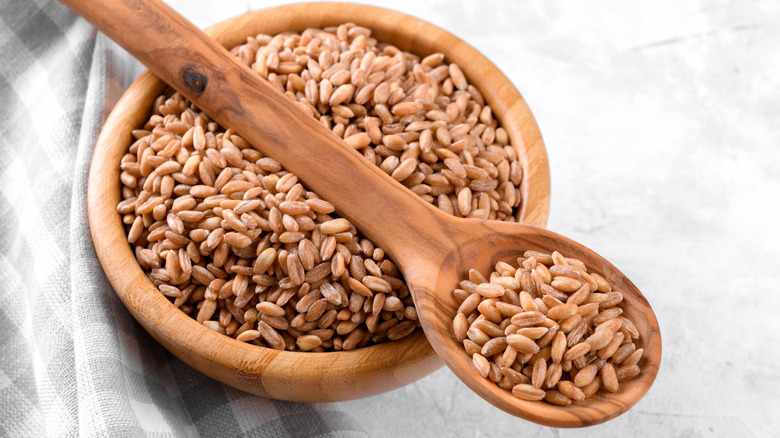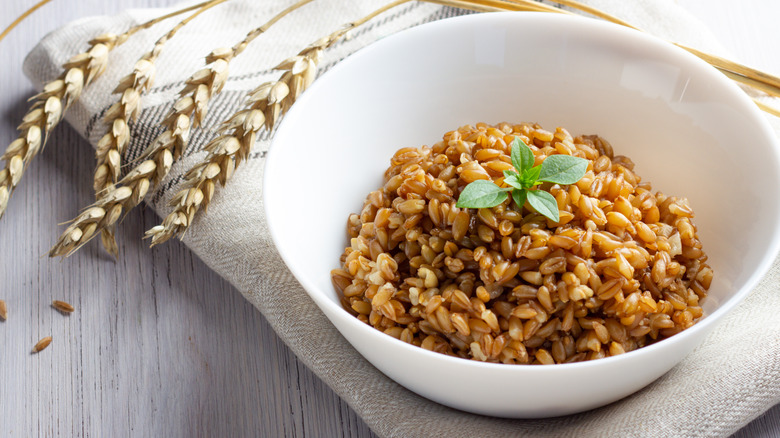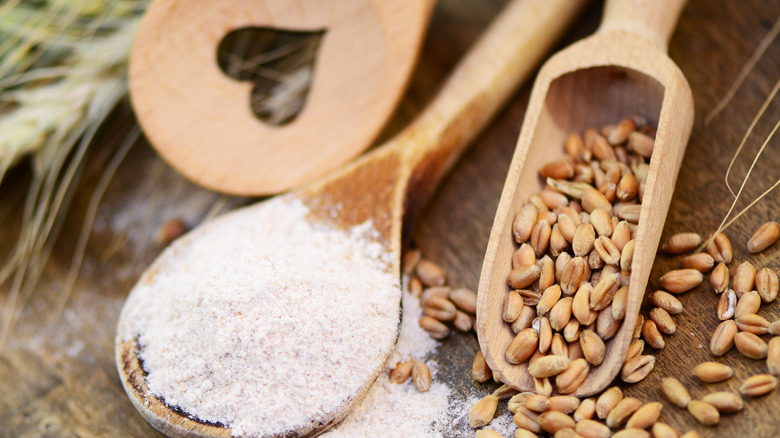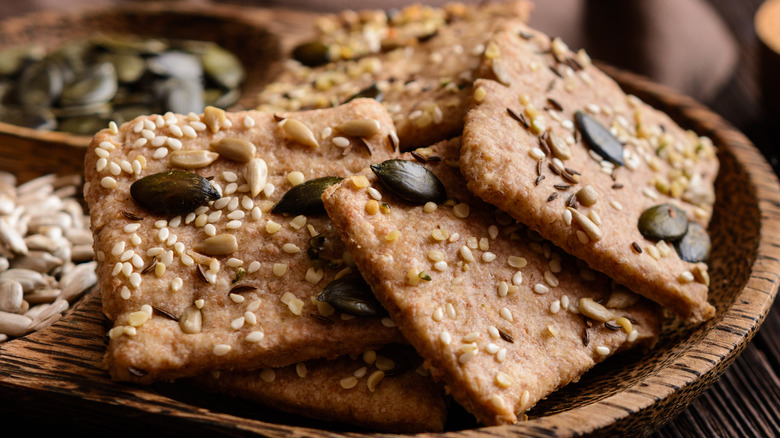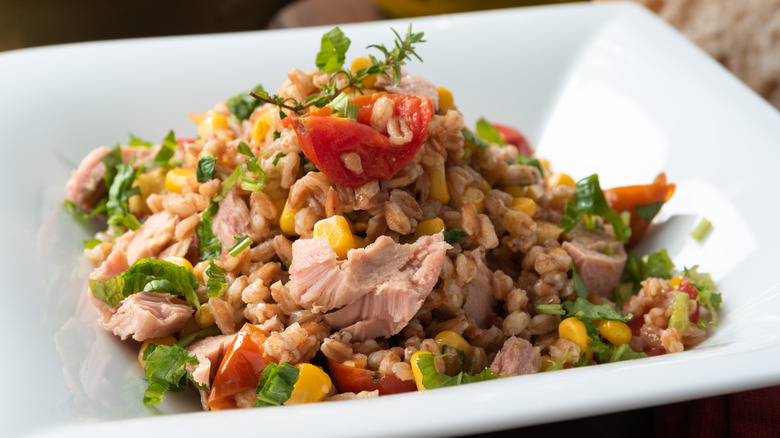Health Benefits Of Eating Farro Every Day
Eating a diet rich in whole grains can benefit your health, but brown rice and wheat bread might get boring day after day. Why not try farro? It has a rich, nutty taste that can enliven your meals. It's considered to be an "ancient grain" because, unlike modern wheat, farro has remained unchanged for thousands of years (per Whole Grains Council).
Farro originally came from the Fertile Crescent of the Middle East, where it eventually made its way into Mediterranean dishes (via NPR). The popular form of farro in the United States is emmer, which is a harder grain than the einkorn and spelt varieties. Although high-profit wheat replaced farro crops in the 20th century, Italy and India are bringing these crops back (via Journal of Food Science). A 2003 paper published in Molecular Nutrition & Food Research found that farro is suitable for organic farming and doesn't need much irrigation, pesticides, or fertilization.
Farro has many health benefits that make it worth eating every day. Because farro is a type of wheat grain, it is not suitable if you're thinking about going gluten-free.
Farro is rich in fiber
Farro has 3 grams of fiber per 1/3 cup serving, which helps you reach your daily fiber intake. According to the Mayo Clinic, women should plan for 21 to 25 grams of fiber per day, and men should strive for 30 to 38 grams. According to the Harvard Medical School, most Americans only get less than a third of that recommendation.
Fiber is healthy in several ways. The anti-inflammatory role of fiber in the gut can reduce the risk of heart disease and diabetes (per Harvard T.H. Chan School of Public Health). Fiber also helps shuttle cholesterol out of the body (via Cleveland Clinic). A 2002 study in the Journal of Family Practice investigated oat fiber, the researchers found that increased fiber can treat high blood pressure.
If you're looking to shed pounds, the fiber in farro can help you feel fuller longer after your meals. A 2005 study in Medical Science Monitor found that supplementing fiber in the diet can contribute to weight loss.
Antioxidant-rich farro
Antioxidants serve as strong warriors that fight cell-damaging free radicals. We need antioxidants each day to defend us from the harmful effects of pollutants in the air or in our bodies. Although many food companies will enrich foods with antioxidants, we can get them naturally from whole grains, such as farro.
According to a 2002 study in the Journal of Agricultural and Food Chemistry, whole grains have bound phytochemicals that hold together throughout the digestive process. That's why consuming these grains regularly can prevent disease in the colon and other digestive organs.
A 2013 study published in the Journal of the Science of Food and Agriculture found that ancient grains, such as farro, have more antioxidant power than modern wheat. Specifically, farro contains magnesium, which helps our nerves and muscles, as well as iron, which helps build hemoglobin (via MedicalNewsToday). You can also find antioxidants such as polyphenols, carotenoids, and selenium in this grain (per Healthline).
Farro is protein-packed
Protein is a macronutrient that helps us repair and maintain healthy muscles and bones. The Dietary Guidelines for Americans recommend 46 grams of protein each day for adult females and 56 grams for adult males. That might not sound like much if you're used to eating a lot of meat. According to the Mayo Clinic, the average adult in the United States gets too much protein.
According to the U.S. Department of Agriculture's (USDA) MyPlate, we should get our protein from a variety of sources, including nuts, seeds, and beans. Whole grains, such as farro, also have a moderate amount of protein that won't overwhelm your system. A 1/3 cup of pearled farro has 5 grams of protein (via USDA's FoodData Central), which might not sound like a lot. However, those choosing a plant-based diet might want to turn to farro for its protein power. Farro's chewy texture and versatility can supplement ordinary dishes that include white rice. Because protein takes longer to digest, it can help control our appetite between meals (per Harvard Medical School).
Farro's low glycemic index
White bread and pasta often contribute to spikes in blood sugar. To prevent these spikes, the American Heart Association suggests complex carbohydrates instead because our bodies digest them more slowly. Because farro has fiber, it takes longer to travel through the digestive system than simple carbohydrates.
Although farro might not be a choice if you're on the keto diet, the type of carbohydrates in farro is important for eating healthy. Carbohydrates are ranked according to the glycemic index, which measures how pronounced the effect is on blood glucose levels. According to the Glycemic Index Foundation, adopting foods with a low glycemic index reduces the risk of type 2 diabetes. Farro has a glycemic index of 45 (per Information About Diabetes). A 2018 study in the Journal of Ethnic Foods found that farro contains nutrients that reduce blood sugar and oxidative stress — two factors that contribute to type 2 diabetes.
Finding and cooking farro
Although you might not find farro in every grocery store, look for it in the organic section near other grains. Farro comes in three forms: pearled, semi-pearled, and whole grain. The pearled versions strip the wheat husk to produce a softer texture. Although the pearled versions cook faster, they lack the fiber and nutritional power of the whole grain variety (via Healthline). If you choose the whole grain, it's best to soak it overnight and cook it a little longer. Be sure to follow the cooking times for your type of farro. If it's overcooked, it can become too mushy. Undercooked farro can be too hard to chew.
This ancient grain can replace rice in your favorite dishes or create a vegan farro salad for a hearty texture. Try stir-frying cooked farro with some potatoes and kale, or substitute farro for rice in your favorite risotto recipe. If you're feeling brave, you can even grind farro and use it to replace flour.

